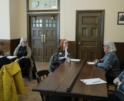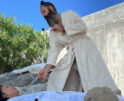
Protect Your Bones

Don’t wait until it’s too late. Here’s what you need to know to have healthy bones now.
By Taylor Mallory
Osteoporosis affects one of every two U.S. women over the age of 50, so chances are good that every woman will either develop osteoporosis or watch a close friend or relative suffer through it. But many women think it’s something they can wait to deal with when it happens. Not true! Osteoporosis can strike at any age, and what you do in the years leading up to menopause can plot the course the disease will take in your body.
Contrary to popular belief, bone is not a lifeless structure, but is a living, growing tissue that is constantly being renewed. By age 20, the average woman has acquired 98 percent of her skeletal mass, so the earlier she begins taking care of her bones, the better.
With help from the National Osteoporosis Foundation (NOF), PINK lists five steps you can take to protect yourself – and your mothers, daughters, sisters and friends – starting now:
1. A balanced diet rich in calcium and vitamin D. Women who are 19 to 49 years old need 1,000 mg of calcium and 400 to 800 IU of vitamin D each day. It’s always best to get vitamins from healthy foods, but since half of us aren’t getting enough, supplements will also do the trick.
• While calcium is necessary for bone health, it also helps the heart, muscles and nerves perform daily functions. Women lose calcium each day by urinating and sweating, but this can be replaced by the 1,000 mg of daily dietary calcium. Dairy products, certain vegetables and fish are excellent sources of calcium. A cup of milk or fortified orange juice has about 300 mg of calcium and 100 IU of vitamin D.
• Your body also needs vitamin D to absorb calcium. Vitamin D is usually added to milk but not to other milk-based products such as cheese, yogurt and butter. Liver, fatty fish and egg yolks also contain vitamin D. Vitamin D also lowers the risk of colon, breast and ovarian cancers, and it has been shown to help prevent hypertension, diabetes and multiple sclerosis.
Click here to see a guide to calcium supplements.
2. Weight-bearing and resistance-training exercises. Try to get at least 30 minutes of exercise a day. Do strength-building and weight-bearing activities to build strong bones, and practice dance, yoga and tai chi for balance and strength.
Women are notorious for taking care of everyone but themselves, and professional and familial demands often take priority in our lives over our own health and fitness. If you can’t make time for the gym, employ your inherent multi-tasking skills for exercise. Take a walk while carrying weights. You can even network while exercising by joining a walking group. WalkStyles.com connects you with others in your area for free. Use tai chi or yoga video in the morning while you organize your day – and what you’ll wear to work – in your head.
At the very least, be more active at work. Park as far away from your building as is safe so you’ll have a short walk. Instead of calling or e-mailing an employee or colleague, walk to her office. (Added bonus: She’ll appreciate your role in lightening her in-box load.) Leslie Blodgett, CEO of Bare Escentuals, takes her shoes off and runs around the office visiting people when she needs to recharge.
3. A healthy lifestyle with no smoking or excessive alcohol intake. Heavy alcohol use and smoking can actually reduce your bone mass, which significantly increases your risk for broken bones. Tried quitting before and failed? Talk to you doctor about new medical breakthroughs – pills and shots are now available – for smoking cessation.
4. Talking to one’s healthcare professional about bone health. Make a list of questions before going in to talk to your doctor, and make sure she answers all of them in full. For help in generating questions, check out “Talking with Your Doctor About Osteoporosis,” a brochure from NOF that lists questions to ask your doctor about your bone health, including:
-
How can I prevent osteoporosis?
-
How can I strengthen my bones?
-
How much calcium and vitamin D do I need, and what are the best sources for them?
-
Do any medications I take affect my bone health?
Visit NOF online at nof.org to learn more, or click here to order the brochure.
5. Bone density testing and medication, when appropriate.Bone mineral density (BMD) tests can measure bone density in various parts of the body and:
-
Detect osteoporosis before a fracture occurs
-
Predict the chances of future fractures
-
Determine rate of bone loss and monitor the effects of treatment if the test is done at intervals of more than one year.
Currently, BMD testing is not a regular screening tool for all women. But your doctor may recommend one if you are post-menopausal or if you have a major risk factor such as menopause before age 45 or a family history of osteoporosis.
Physicians may also prescribe medication to prevent or treat osteoporosis. The FDA has approved the following medications:
-
Alendronate (brand name Fosamax)
-
Ibandronate sodium (brand name Boniva)
-
Risedonate (brand name Actonel)
-
Calcitonin (brand name Miacalcin, Fortical)
-
Estrogen/hormone therapy (including brand names Climara, Estrace, Estraderm, Estratab, Ortho-Est and others)
-
Parathyroid hormone (brand name Fortéo)
-
Raloxifene (brand name Evista)
Your Turn
The National Osteoporosis Foundation offers free access to osteoporosis information and responds to thousands of health information requests from individuals and health professionals. Each call, e-mail and letter is addressed by staff in NOF’s Education Department. Click nof.org or call 800.231.4222 for more information on osteoporosis and bone health – and sign up for NOF’s quarterly newsletter.
Click here to read “Osteoporosis: What’s Your Risk Factor?” and “Got (No) Milk: PINK’s Guide to Calcium-Rich Foods and Supplements”.
Recommended
-
5 Skin Care Trends: What Profe...April 10th, 2024
-
Is It Time To Change Your Rela...March 20th, 2024
-
Resilience & Transformati...February 20th, 2024
-
Medical Malpractice Lawsuits: ...October 31st, 2023
-
Be Here Now—Two Easy StepsSeptember 19th, 2023















